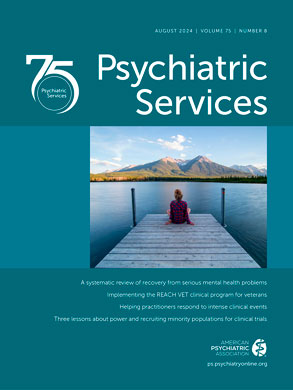Treatment of Opioid Dependence via Home-Based Telepsychiatry
To the Editor: The Food and Drug Administration's approval of the drug buprenorphine in 2002 changed the landscape in terms of our ability to manage opioid dependence. Yet because of the relatively small number of buprenorphine-certified physicians and sluggish efforts at public education, a majority of patients with opioid dependence, particularly in rural areas, go without this definitive treatment.
Simultaneously, we have seen personal use of broadband Internet expand from 10% of the population in 2002 to its current rate of 55% (
1 ), as well as the release of numerous versions of consumer videoconferencing software, such as iChat with secure encryption for the Macintosh and Skype or SightSpeed for both PC and Mac platforms. When combined with broadband Internet and a midrange Webcam, these software packages offer a quality of video and audio that is surprisingly fluid and clearly sufficient for use in a new model of telepsychiatry—home-based telepsychiatry.
Over the past two years, I have treated approximately 40 opioid-dependent patients from communities throughout Colorado, all of whom were seen exclusively via telepsychiatry from their own homes or offices. Many of these patients are affluent professionals seeking treatment for covert addiction to narcotic analgesics, who were relieved to find an option providing both convenience and confidentiality. Few have chronic mental illness other than addiction.
The standard of care of general outpatient psychiatry is maintained. After a routine intake, a prescription for buprenorphine is arranged when clinically appropriate by telephone with the patient's local pharmacy. Induction is achieved at home, in some cases with intermittent on-camera contact, and follow-up occurs at appropriate intervals. Patients are required to contact their primary care physicians for laboratory tests and physical examinations as indicated. Many are required to participate in ancillary psychosocial treatments, such as Narcotics Anonymous, or in local random urine screening programs. In many cases, the patient's spouse or family member appeared on camera to participate and collaborate in treatment.
This treatment model has some limitations. Home-based telepsychiatry may not be appropriate for all patients, many of whom will continue to need more traditional therapies and case management. Patients without resources for high-speed Internet and a Webcam may be excluded. In additional, not all malpractice carriers support home-based telepsychiatry as defined here (although the number is growing). The Campania Group, a forward-thinking organization with wide support for telemedicine, is a notable exception.
Treatment of opioid dependence with buprenorphine via home-based telepsychiatry is a powerful combination of diagnosis and treatment. This process offers the potential to balance the supply of buprenorphine-prescribing physicians with statewide demand; the catchment area is limited only by state licensure. As this process becomes more widely accepted by physicians, patients, and the insurance industry, it may well represent the long-sought realization of the potential for telepsychiatry as an efficacious and cost-saving modality (
2 ) with far-reaching implications.

